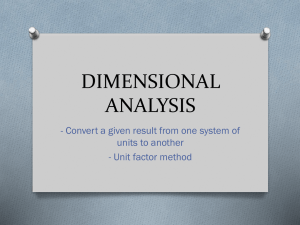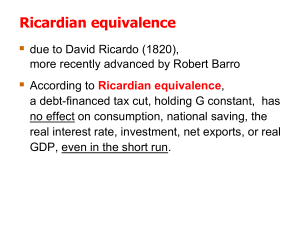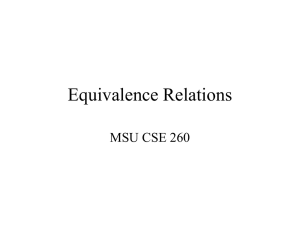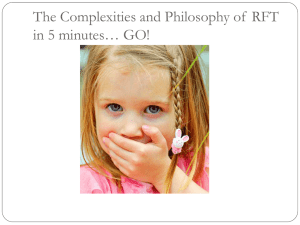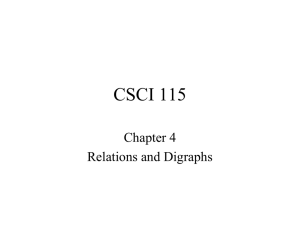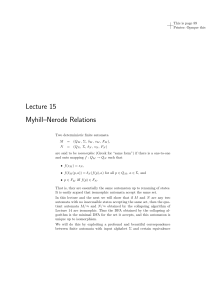MYHILL-NERODE-THEOREM
advertisement
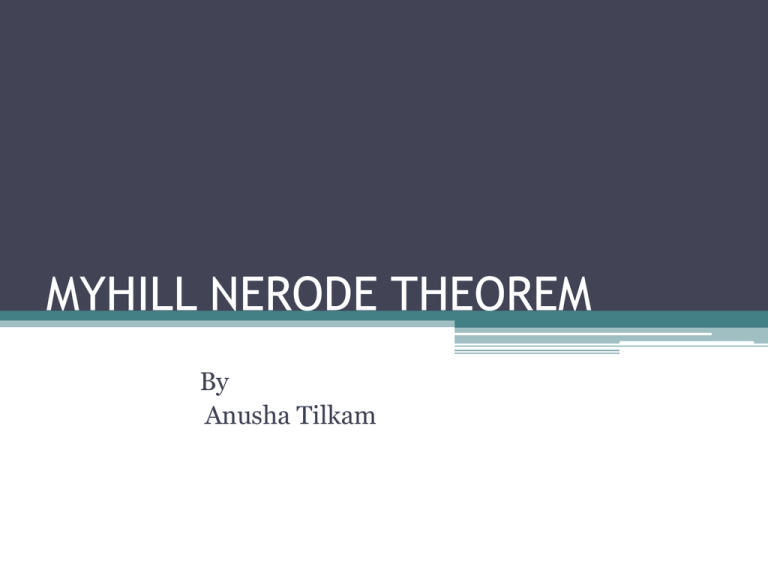
MYHILL NERODE THEOREM
By
Anusha Tilkam
Myhill Nerode Theorem:
The following three statements are equivalent
1. The set L є ∑* is accepted by a FSA
2. L is the union of some of the equivalence classes of a
right invariant equivalence relation of finite index.
3. Let equivalence relation RL be defined by :
xRLy iff for all z in ∑* xz is in L exactly when yz is in L.
Then RL is of finite index.
Theorem Proof:
• There are three conditions:
1. Condition (i) implies condition (ii)
2. Condition (ii) implies condition (iii)
3. Condition (iii) implies condition (i)
Equivalence Relation
A binary relation ̴ over a set X is an equivalence
relation if it satisfies
• Reflexivity
• Symmetry
• Transitivity
Condition (i) implies condition (ii)
Proof:
Let L be a regular language accepted by a DFSA
M = (Q,∑,δ,q0,F).
Define RM on ∑*
x RM y if δ(q0 , x) = δ(q0 , y)
In order to show that its an equivalence relation it
has to satisfy three properties.
• δ(q0 , x) = δ(q0 , x) --- Reflexive
• If δ(q0 , x) = δ(q0 , y) then
δ(q0 , y) = δ(q0 , x) --- Symmetry
• If δ(q0 , x) = δ(q0 , y)
δ(q0 , y) = δ(q0 , z) then
δ(q0 , x) = δ(q0 , z) --- Transitive
• Index of an Equivalence relation:
There are N states
q0
q1
q2
qn-1
If This RM is an Equivalence Relation, Then the
index of RM is at most the number of States of M
• Right invariant
If x RM y
Then xz RM yz for any z є ∑*
Then we say RM is Right invariant
Proof:
δ(q0 , x) = δ(q0 , y)
δ(q0 , xz) = δ( δ(q0 , x), z )
= δ( δ(q0 , y), z )
= δ(q0 , yz)
Therefore RM is right invariant
• L is the union of sum of the equivalence classes of
that relation.
If the Equivalence Relation RM has n states.
S0 , S1 , S2, ……, Si ,…….. , Sn-1
| | |
|
|
q0 , q1 , q2 ,….., qi ,…..…, qn-1
• Condition (ii) implies condition (iii) :
Proof:
Let E be an equivalence relation as defined in (ii).
We have to prove that
E is a Refinement of RL.
What is Refinement?
x E y | x,y є to same equivalence class of E
xz E yz | xz is related to yz for any z є ∑*
L is the union of sum of the equivalence classes of E. If
L contains this equivalence class then xz and yz are in
L or it may not be in L.
Then we can say that
x RL y
Hence it is proved that every equivalence class in E is an
Equivalence class in RL
Then we can say that E is a Refinement of RL
E is of finite index
Index of RL <= index of E
therefore RL is of Finite index.
• Example : DFA
b
b
b
a
q0
a
q2
q1
a
L ={ w | w contains a stings having atleast one a ,no
sequence of b}
∑* is partioned into three equivalence class J0,J1,J2
J0
J1
J2
є
a
aa
b
ba
aba
bb
babaa
babab
…… so on
……so on
……..so on
J0 – strings which do not contain an a
J1 – strings which contain odd number of a’s
J2 - strings which contain even number of a’s
L = J1 U J2
• Condition (iii) implies condition (i)
Proof:
RL is right invariant
x RL y if xz є L
yz є L
Therefore if z = wz then
xwz є L
ywz є L for any w and z
Then xwz RL ywz
Hence RL is Right invariant
Define an FSA M’ = (Q’, ∑,δ’,q0 ’ ,F’) as follows:
For each equivalence class of RL ,we have a state in Q’.
|Q’| = index of RL
• If x є ∑* denote the Equivalence class of RL to which x є to
[x]
q0’ = [є] belongs to initial state / one equivalence class.
For symbol a є ∑
δ’([x],a) = [xa]
This definition is consistent because RL is right invariant.
If xRL y then
δ([x],a) = [ya]
Because x,y belong to same class and Right invariant.
Therefore we can say that L is accepted by a FSA.
• Example :
J0 and J1 U J2 are the two equivalence classes in
RL
a,b
b
a
J0
J1 , J 2
To show that a given language is not
Regular:
• L = {anbn |n>=1}
Assume that L is Regular
Then by Myhill Nerode theorem we can say that L is the
union of sum of the Equivalence classes and etc
a, aa,aaa,aaaa,……..
Each of this cannot be in different equivalence classes.
an ~ am for m ≠ n
By Right invariance
anbn ~ am bn
for m ≠ n
Hence contradiction
The L cannot be regular.
Conclusion
• Shown how the Myhill Nerode theorem helps in
minimizing the number of states in a DFA.
• How it shows that the language is not regular.
References
• Languages and Machines
Thomas A. Sudkamp, Addison Wesley
• http://en.wikipedia.org/wiki/Myhill%E2%80%9
3Nerode_theorem
Thank You

